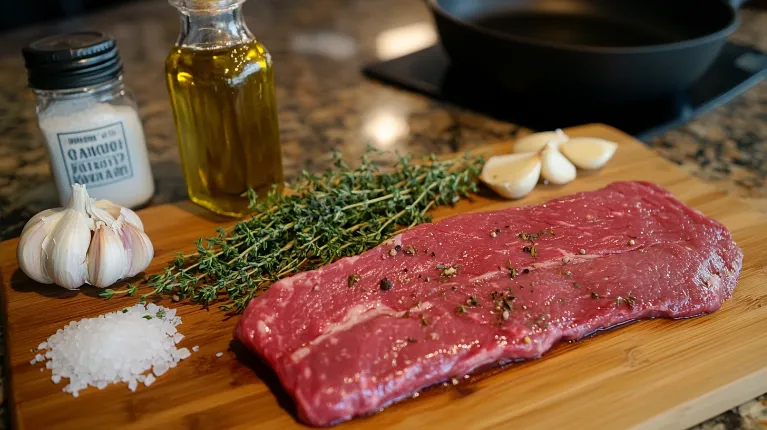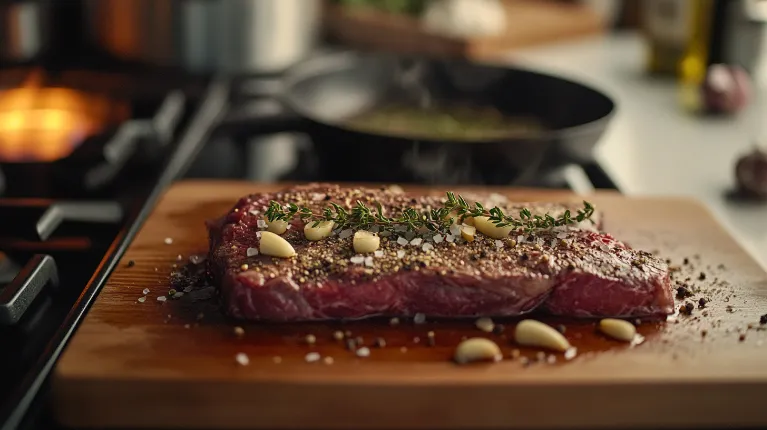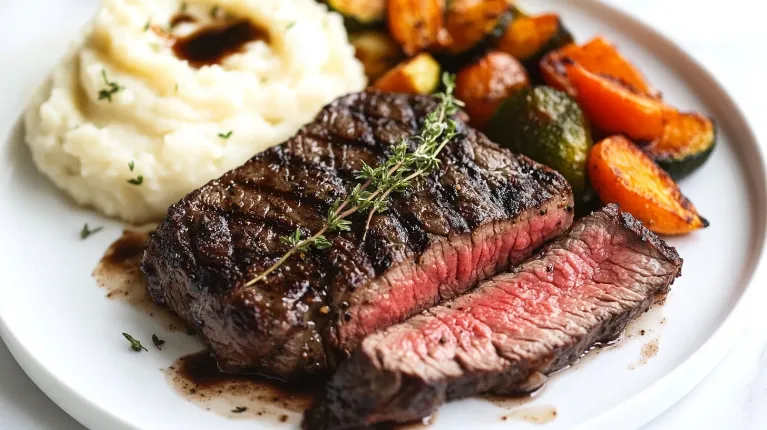Introduction
Let’s be real—when it comes to beef, there’s a whole world of cuts, grades, and labels that can make anyone’s head spin. But today, we’re diving into the beef loin flat iron steak label. Why this cut, you ask? Because it’s like the dark horse of the steak world—tender, flavorful, and totally underrated. Understanding the beef loin flat iron steak label can help you make smarter, tastier choices at the butcher’s counter and ensure you’re getting the best quality every time.
In this guide, we’ll break down everything from what makes flat iron steak so special to how to decode its label like a pro. Whether you’re a grill master or just looking for your next dinner star, the beef loin flat iron steak label holds the key to a great meal. Before we dive in, check out this article on understanding beef labels—it’s a great starting point if you want to nerd out a little more.
History and Origin
The Origins of Flat Iron Steak
Would you believe flat iron steak used to be considered scrap? Yep, this gem comes from the shoulder, or chuck area, and for the longest time, it wasn’t even a thing. It took some crafty butchers in the early 2000s to realize that this overlooked section of the cow hides a marvelously tender, marbled piece of meat. Kind of like finding treasure in your backyard, right? This discovery marked the beginning of what we now recognize on the beef loin flat iron steak label.
Cultural Significance
Flat iron steak isn’t just another cut—it’s a cut with a story. Popularized in the U.S., it’s now gaining traction worldwide for its versatility. Whether it’s marinated for tacos or simply seared with salt and pepper, this steak adapts to cuisines like a pro. Fun fact: Some even call it the “butcher’s secret” because it was often kept for themselves. These days, the beef loin flat iron steak label ensures that this once-hidden gem is accessible to all, no matter your cooking style.
Evolution of the Label
Labeling laws for beef have evolved to give consumers transparency. Back in the day, it was just about slapping a price tag on it. Nowadays, you’ll see USDA grades, country of origin, and sometimes even cooking tips printed right on the beef loin flat iron steak label. This not only helps consumers make informed decisions but also guarantees the quality of the cut.
Ingredients in Table and Equipment
When preparing the perfect flat iron steak, having the right ingredients and tools is just as important as understanding the beef loin flat iron steak label. Here’s everything you’ll need to create a mouthwatering dish.
Ingredients Table
| Ingredient | Quantity | Suggested Substitutions |
|---|---|---|
| Flat Iron Steak | 1.5 lbs | Flank steak or skirt steak |
| Olive Oil | 2 tbsp | Avocado oil |
| Garlic Cloves (minced) | 4 cloves | Garlic powder (1 tsp) |
| Fresh Thyme | 1 tsp | Dried thyme (1/2 tsp) |
| Salt | To taste | Kosher salt |
| Black Pepper | To taste | Smoked paprika for added depth |

Each ingredient plays a role in enhancing the natural flavor of the flat iron steak. If substitutions are needed, rest assured these alternatives will still do justice to your dish.
Equipment Needed
- Cast Iron Skillet or Grill: Essential for achieving that perfect sear.
- Meat Thermometer: For ensuring the steak reaches your desired level of doneness.
- Cutting Board: A sturdy surface for resting and slicing the steak.
- Sharp Knife: Necessary for slicing against the grain.
- Tongs: A reliable tool for flipping without piercing the steak.
With your ingredients prepped and tools at the ready, you’re well on your way to mastering the art of flat iron steak. Next, we’ll decode the beef loin flat iron steak label and explore the steps for cooking it to perfection. Stay tuned!
Cooking and Preparing Flat Iron Steak
Cooking flat iron steak isn’t rocket science, but it does require some finesse to bring out its best flavors. Whether you’re searing it on a cast iron skillet or firing up the grill, the key is precision and patience. In this section, we’ll guide you through the step-by-step process of preparing and cooking a beef loin flat iron steak label to create a dish that’s juicy, tender, and bursting with flavor.
Step 1: Preparing the Steak
Before you even think about turning on the heat, you need to prep your steak properly. First, take the beef loin flat iron steak out of the fridge and let it rest at room temperature for about 30 minutes. Why? Because cooking cold meat can result in uneven doneness.
While the steak rests, pat it dry with a paper towel. This removes excess moisture, helping you achieve that golden-brown crust when you cook it. Next, season the steak generously on both sides with salt and black pepper. For extra flavor, rub it with minced garlic and fresh thyme, pressing the seasonings into the meat gently.
Helpful Tip:
Don’t skimp on the seasoning! A well-seasoned steak is the foundation of a great meal.
Step 2: Heating the Pan or Grill
Heat is your best friend when it comes to cooking flat iron steak. If you’re using a cast iron skillet, place it on medium-high heat and let it warm up for 2-3 minutes. Drizzle a small amount of olive oil into the pan and swirl it around to coat the surface evenly. For those using a grill, preheat it to high heat—aim for about 450°F.
Why Heat Matters:
Starting with a hot surface ensures that the steak sears quickly, locking in the juices and creating that irresistible crust.
Step 3: Searing the Steak
Once the pan or grill is hot, it’s time to sear. Place the beef loin flat iron steak in the skillet or on the grill and hear that satisfying sizzle. Let it cook undisturbed for 3-4 minutes. This creates the Maillard reaction, a fancy term for the browning that adds depth and complexity to the steak’s flavor.
After the first side is done, flip the steak using tongs. Cook the other side for another 3-4 minutes. If you like your steak medium-rare, aim for an internal temperature of 130°F. Use a meat thermometer to check—don’t just guess!

Pro Tip:
Avoid pressing down on the steak while it cooks. You don’t want to lose those precious juices.
Step 4: Resting the Steak
This step is non-negotiable. Once the steak is done cooking, transfer it to a cutting board and let it rest for 5-10 minutes. Resting allows the juices to redistribute, ensuring every bite is moist and flavorful.
While the steak rests, take a moment to clean up or prep any sides you’re serving. Trust us, the wait is worth it.
Step 5: Slicing and Serving
The way you slice your steak can make or break your presentation. Using a sharp knife, cut the steak against the grain into thin slices. Slicing against the grain shortens the meat fibers, making each bite more tender.
Serve your flat iron steak with your favorite sides—think roasted vegetables, mashed potatoes, or a crisp salad.
Bonus Tips for Cooking Flat Iron Steak
- Marinate for More Flavor: If you have time, marinate the steak for a few hours before cooking. A mix of soy sauce, olive oil, and lemon juice works wonders.
- Try Compound Butter: Top your cooked steak with a pat of herb-infused butter for a restaurant-quality finish.
- Experiment with Rubs: Spice things up with a dry rub featuring smoked paprika, cumin, and chili powder.
Troubleshooting Common Issues
- Steak Too Tough: You may have overcooked it. Flat iron steak is best enjoyed medium-rare to medium.
- Lack of Crust: Make sure your pan or grill is hot enough before adding the steak.
- Uneven Cooking: Use a meat thermometer to ensure accurate doneness.
Cooking a beef loin flat iron steak label might seem intimidating at first, but with these steps, you’ll nail it every time. The beauty of this cut is its versatility—it shines whether you keep it simple or go all out with marinades and sides. So, grab your skillet or fire up the grill and let’s get cooking!
Stay tuned for Part 4, where we’ll decode beef labels and understand what makes flat iron steak stand out in the meat aislee
Tips for Perfecting the Recipe
Making a beef loin flat iron steak can be a rewarding experience, but let’s face it—there’s always room to up your game. Whether you’re cooking it for the first time or you’re a seasoned steak enthusiast, these tips will help you take your dish to the next level.
Common Challenges and How to Fix Them
- Uneven Cooking: If one side of your steak cooks faster than the other, it’s likely due to uneven heat. However, you can solve this by rotating the steak halfway through cooking or adjusting the heat to medium-low.
- Overcooking: Flat iron steak can quickly go from tender to tough if left too long on the heat. Always use a meat thermometer to ensure you hit that perfect medium-rare temperature (130°F).
- Dry Texture: This usually happens if the steak isn’t rested after cooking. On the other hand, letting it rest for 5-10 minutes locks in the juices, keeping it moist and flavorful.
Pro Tips for a Stellar Flat Iron Steak
- Preheat with Care: Whether you’re grilling or using a skillet, ensure the cooking surface is hot enough to create a nice crust. A hot surface also ensures the meat cooks evenly.
- Season Generously: Salt and pepper are classic, but adding garlic, thyme, or smoked paprika can elevate the flavor and make the steak stand out.
- Slice It Right: Always cut against the grain to shorten the meat fibers, which results in a more tender bite.
For more inspiration on plating and garnishing, check out this Plating Guide for Goat Cheese and Pistachio Bruschetta—it’s perfect for pairing ideas with flat iron steak.
By following these tips, you’ll transform your flat iron steak into a dish that’s not only delicious but also visually appealing. Whether it’s your first time cooking a beef loin flat iron steak label cut or you’re fine-tuning your skills, these suggestions ensure a perfect result every time.
Serving and Garnishing Ideas
Once your beef loin flat iron steak is perfectly cooked, it’s time to think about presentation. A well-plated steak not only looks great but also enhances the entire dining experience. Let’s dive into some creative ways to make your dish as visually appealing as it is delicious.
Creative Presentation Tips
- Layered Presentation: Slice the steak and fan the pieces out on the plate for a polished and professional look.
- Pop of Color: Brighten the plate with garnishes like fresh herbs, edible flowers, or a sprinkling of microgreens. These additions not only look stunning but also add subtle flavor.
- Modern Minimalism: Keep it sleek and elegant with a drizzle of balsamic glaze and a small mound of mashed potatoes, letting the steak be the star of the plate.
Pro Tip:
Use a large, white plate to make your steak and garnishes pop visually—it’s a restaurant trick that works wonders!
Suggested Side Dishes
Pairing your steak with the right sides can elevate the flavors and make your meal unforgettable. Here are some tried-and-true options:
- Roasted Vegetables: Carrots, asparagus, or Brussels sprouts roasted with olive oil and garlic are perfect complements to the steak’s richness.
- Potato Dishes: Garlic mashed potatoes, crispy roasted fingerlings, or even sweet potato fries pair beautifully with the savory steak.
- Fresh Salads: A tangy arugula and Parmesan salad adds a refreshing contrast to the steak’s bold flavors.
Bonus Idea:
For a vibrant and zesty side, try our Carrot and Chickpea Salad with Parsley and Lemon. It’s the perfect pairing for a beef loin flat iron steak.
Bringing It All Together
With these plating and side dish ideas, your beef loin flat iron steak label recipe will not only taste incredible but also look like it belongs in a five-star restaurant. Whether you’re serving guests or just treating yourself, a well-plated steak creates a memorable dining experience.
Ready to impress your guests? Slice, plate, garnish, and let the compliments roll in. Bon appétit!
Healthier Alternatives and Dietary Considerations
Cooking a beef loin flat iron steak can be tailored to fit a variety of dietary needs without sacrificing flavor. Whether you’re trying to cut calories, reduce fat, or cater to specific dietary preferences, there are plenty of options to explore.
Healthier Ingredient Swaps
- Low-Sodium Seasoning: Instead of regular salt, opt for a low-sodium alternative or use natural flavor boosters like garlic and lemon zest.
- Healthy Fats: Replace olive oil with avocado oil or a light spray of cooking oil to reduce fat content.
- Vegetarian Twist: While flat iron steak is all about beef, you can swap it for a plant-based steak substitute to create a vegetarian-friendly version.
Pro Tip:
For a leaner cut, you might consider substituting flat iron steak with flank steak or sirloin. These options maintain great flavor with slightly lower fat content.
Dietary Variations
- Keto-Friendly: Pair your steak with cauliflower mash or sautéed spinach for a low-carb meal.
- Gluten-Free: Stick with natural seasonings and avoid sauces with hidden gluten, such as soy sauce. Tamari is an excellent gluten-free alternative.
For more creative ideas on incorporating dietary preferences, check out our Healthy Salmon and Sweet Potato Lunch.
Beverage Pairings
Additionally, the right beverage can elevate your steak experience. For example:
- Red Wine: A medium-bodied Merlot or Cabernet Sauvignon complements the richness of the steak.
- Non-Alcoholic Options: Sparkling water with a slice of lemon or an iced herbal tea works well for a refreshing contrast.
Storing and Reheating Flat Iron Steak
Leftovers can be just as delightful as the original meal—if stored and reheated properly. Let’s walk through the best practices.
Storing Your Steak
- Refrigeration: Wrap leftover steak tightly in aluminum foil or store it in an airtight container. It will keep well for up to 3 days.
- Freezing: For longer storage, place steak in a freezer-safe bag, removing as much air as possible. Freeze for up to 3 months.
Reheating Tips
When reheating, the goal is to preserve the steak’s tenderness without overcooking:
- Oven Method: Preheat your oven to 250°F, wrap the steak in foil, and warm it for about 15 minutes.
- Stovetop: Slice the steak and reheat in a skillet over medium heat with a splash of broth to keep it moist.
- Microwave: Use the microwave only as a last resort. Heat the steak on 50% power in short intervals to prevent drying out.
Bonus Tip:
Slice and use leftover steak in salads, wraps, or tacos for a quick meal the next day. With these strategies, your beef loin flat iron steak label recipe remains delicious, even as leftovers!
From healthier swaps to reheating techniques, these final touches ensure your steak experience is not only flavorful but also practical and versatile.
Frequently Asked Questions (FAQs)
When it comes to the beef loin flat iron steak label, questions abound. From its quality to its cost, we’ve got answers to help you navigate your next steak purchase with confidence.
What is a flat iron beef steak?
Flat iron steak is a tender and flavorful cut of beef taken from the shoulder, or chuck, of the cow. For example, it’s known for its marbling and buttery texture, making it perfect for grilling or pan-searing. Its unique name comes from its flat, rectangular shape, resembling an old-fashioned flat iron.
Is flat iron steak good quality?
Absolutely! Flat iron steak is considered one of the most tender cuts after the tenderloin. Consequently, it’s a favorite among chefs and home cooks for its versatility and rich flavor. The beef loin flat iron steak label typically reflects its high quality with details about its grade and marbling.
Is flat iron steak a cheap cut?
Not anymore. While it was once an affordable option, its growing popularity has driven up the price. However, compared to premium cuts like ribeye or filet mignon, it’s still relatively budget-friendly while delivering comparable tenderness and taste.
Why is flat iron steak so expensive?
The demand for flat iron steak has soared in recent years, thanks to its tender texture and bold flavor. Additionally, the steak is cut from a small section of the cow, which limits supply. This combination of high demand and low availability makes it pricier than it used to be.
Can flat iron steak fit into a specific diet?
For example, it’s an excellent choice for high-protein diets like keto or paleo. By opting for lean seasoning and low-calorie sides, it can also suit those watching their fat intake.
How should I store leftover flat iron steak?
Store cooked steak in an airtight container in the fridge for up to three days. For longer storage, freeze it using a vacuum-sealed bag or freezer-safe container. When reheating, use the oven or stovetop to maintain its tenderness.
Conclusion
Cooking and understanding the beef loin flat iron steak label can elevate your dining experience. From selecting the perfect cut to mastering its preparation, every step contributes to a meal that’s not just delicious but also memorable.
Flat iron steak offers a fantastic balance of tenderness, flavor, and versatility. Whether you’re grilling it to perfection or repurposing leftovers for a quick salad, this cut proves its worth every time.
We hope this guide inspires you to try your hand at cooking flat iron steak. Share your experiences in the comments, and let us know your favorite tips or variations. If you’re looking for more culinary inspiration, check out our Creamy Chicken and Rice Lunch Recipe for another hearty and satisfying dish.
Thank you for joining us on this flavorful journey. Happy cooking!




